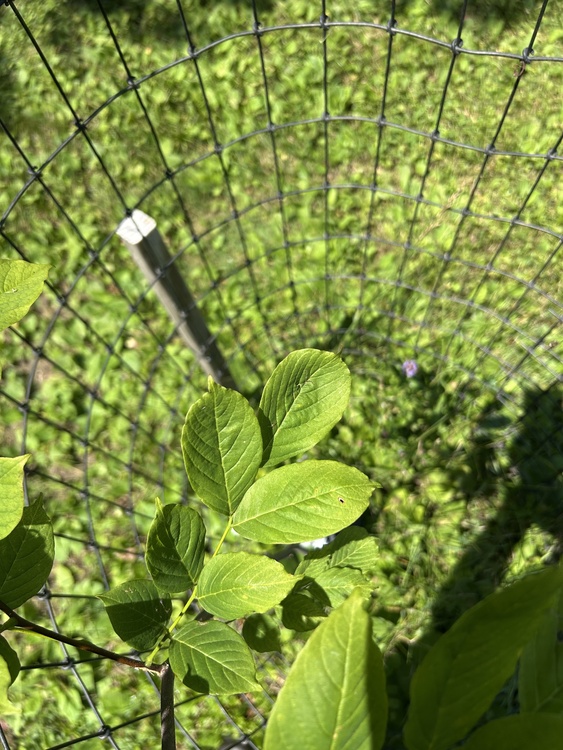Yellowwood
Here stands the American Yellowwood, or Cladrastis kentukea. It's a rare native tree of the eastern U.S., named for its yellow heartwood. It grows up to 60 feet tall with a broad, rounded crown and a short, divided trunk. In May, it produces large clusters of fragrant white flowers resembling wisteria. The bark was once used by pioneers to make yellow dye, and its wood was valued for gunstocks. Yellowwood grows slowly and is short-lived, rarely surviving beyond 150 years. It prefers well-drained, streamside soils with some shade but can also grow in full sun. It does not tolerate drought or flooding and offers little wildlife value due to its rarity in natural habitats. Pruning is important early on to prevent low branching. In fall, its foliage turns bright yellow, and the smooth gray bark offers year-round appeal. Leaves are singly compound with 7–9 leaflets, and its thin, papery, tan seed pods persist through winter.
-
Arborvitae, Emerald Green
-
Arborvitae, Green American
-
Arborvitae, Green Giant
-
Artemis I Moon Tree 23
-
Ash, Black
-
Ash, Blue
-
Ash, Green
-
Ash, Red
-
Ash, White
-
Aspen, Quaking
-
Basswood, American
-
Beech, American
-
Beech, Cut Leaf European
-
Birch, River
-
Birch, Yellow
-
Blackgum
-
Blackgum, Wildfire
-
Blackhaw
-
Bladdernut, American
-
Box Elder
-
Buckeye, Ohio
-
Buckeye, Red
-
Buckeye, Sweet
-
Butternut
-
Catalpa, Northern
-
Cedar, Eastern Red
-
Cherry, Black
-
Chestnut, Hybrid
-
Chokeberry, Brilliant Red
-
Coffee Tree, Kentucky
-
Cottonwood, Eastern
-
Cypress, Bald
-
Dogwood, Flowering
-
Dogwood, Pagoda
-
Elm, Cork
-
Elm, Frontier
-
Elm, Princeton
-
Elm, Slippery
-
Ginkgo
-
Hackberry, Common
-
Hawthorn
-
Hawthorn, Winterking
-
Hemlock, Canadian
-
Hickory, Bitternut
-
Hickory, Pignut
-
Hickory, Shagbark
-
Hickory, Shellbark
-
Hornbeam, American
-
Hornbeam, Frans Fontaine
-
Hornbeam, Rockhampton Red
-
Horsechestnut, Autumn Splendor
-
Horsechestnut, Double White
-
Ironwood
-
Locust, Black
-
Locust, Honey
-
Magnolia, Cucumber
-
Maple, Armstrong Red
-
Maple, Armstrong Gold
-
Maple, Black
-
Maple, Brandywine Red
-
Maple, Commemoration Sugar
-
Maple, Fall Fiesta Sugar
-
Maple, Green Mountain Sugar
-
Maple, October Glory Red
-
Maple, Red Sunset
-
Maple, Silver
-
Maple, Sugar
-
Maple, Wright Brothers Sugar
-
Ninebark, Common
-
Oak, Black
-
Oak, Blackjack
-
Oak, Bur
-
Oak, Chestnut
-
Oak, Chinquapin
-
Oak, Northern Red
-
Oak, Pin
-
Oak, Regal Prince
-
Oak, Sawtooth
-
Oak, Scarlet
-
Oak, Shingle
-
Oak, Shumard
-
Oak, Swamp White
-
Oak, White
-
Osage Orange
-
Paw Paw
-
Pecan
-
Persimmon, Common
-
Pine, White
-
Plum, American
-
Redbud, Eastern
-
Redwood, Dawn
-
Redwood, Gold Rush Dawn
-
Sassafras
-
Serviceberry, Autumn Brilliance Apple
-
Serviceberry, Cumulus Alleghany
-
Smoketree
-
Spicebush, Northern
-
Spruce, Norway
-
Sumac, Staghorn
-
Sweetgum, American
-
Sweetgum, Moraine
-
Sycamore, American
-
Tulip Tree
-
Virginia Creeper
-
Walnut, Black
-
Witchhazel, Common
-
Winterberry (Female)
-
Winterberry (Male)
-
Yellowwood

